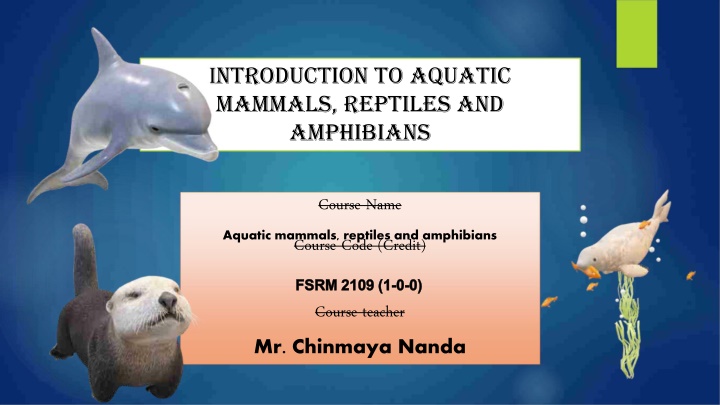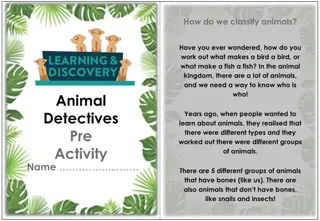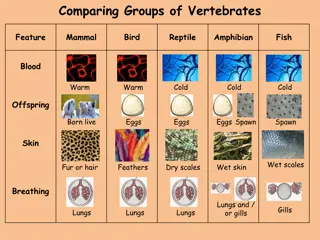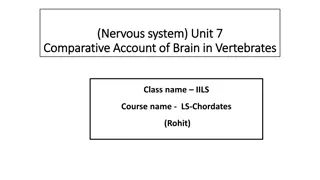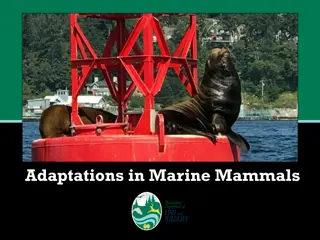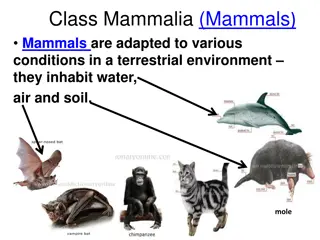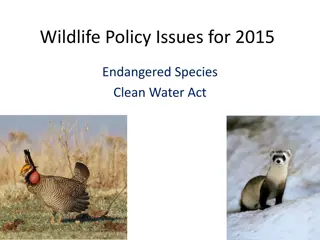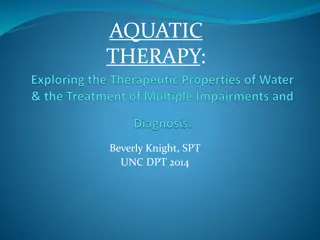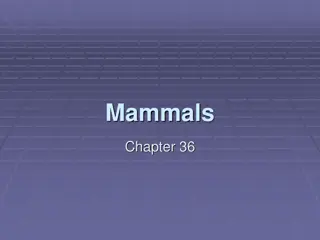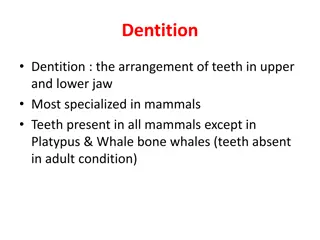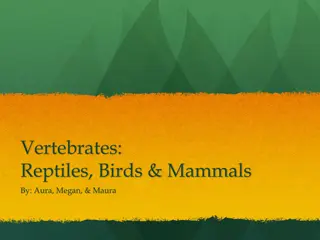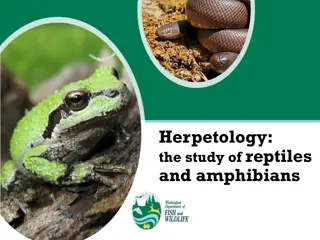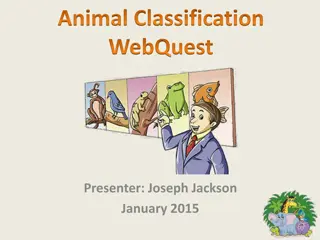Introduction to Aquatic Mammals, Reptiles, and Amphibians Course
Explore the diverse world of aquatic mammals, reptiles, and amphibians in this comprehensive course. Covering topics from taxonomy and distribution to conservation and exploitation, delve into the biology and characteristics of species like whales, sea turtles, crocodiles, and more. Learn about IUCN criteria, wildlife protection laws, and the importance of conservation efforts. With engaging class structures and assessments, gain a deeper understanding of these fascinating aquatic creatures.
Download Presentation

Please find below an Image/Link to download the presentation.
The content on the website is provided AS IS for your information and personal use only. It may not be sold, licensed, or shared on other websites without obtaining consent from the author.If you encounter any issues during the download, it is possible that the publisher has removed the file from their server.
You are allowed to download the files provided on this website for personal or commercial use, subject to the condition that they are used lawfully. All files are the property of their respective owners.
The content on the website is provided AS IS for your information and personal use only. It may not be sold, licensed, or shared on other websites without obtaining consent from the author.
E N D
Presentation Transcript
ntroduction to aquatic mammals, reptiles and amphibians Course Name Aquatic mammals, reptiles and amphibians Course Code (Credit) FSRM 2109 (1 FSRM 2109 (1- -0 0- -0) 0) Course teacher Mr. Chinmaya Nanda
UNIT 1: UNIT 1: Selected Aquatic Mammal, Reptile, Amphibian And Birds Species of India relevant to Fisheries: Taxonomic Status, Identification Characters, Distribution, Abundance, Habitat, Exploitation, Threats And Conservation. Unit 2: Unit 2: Biology Of Aquatic Animals: Cetaceans (Whales. Dolphins, Porpoises And Narwal), Sirenia (Manatees And Dugongs), Carnivora (Seals, Sea Lions, Walruses, Polar Bear And Otter), Sea Turtles, Tortoise, Crocodiles, Sea/Freshwater Snakes And Amphibians. Unit 3: Unit 3: IUCN Criteria Red List, Wild Life (Protection) Act.
ARMA Course Credit= 1+0+0 *1 Credit= 50 Marks INTERNAL THEORY EXAM INTERNAL THEORY EXAM END SEMESTER/EXTERNAL THEORY EXAM END SEMESTER/EXTERNAL THEORY EXAM (60%) (60%) (40%) (40%) Internal Internal- -1 1 Internal Internal- -2 2 (10 Marks) (10 Marks) (Continuous Assessment) (Continuous Assessment) Final Theory Exam Final Theory Exam Presentation or (30 Marks) (30 Marks) Class Attendance Assignments (2.5 Marks) (7.5 Marks)
Class Planning Each Class= 1hrs 1hrs First First 10 10 Min Min= Presentations by two students and discussion Next 30 Next 30- -40 Min 40 Min= Usual Class Progression Last 5 Minutes Last 5 Minutes= MCQ related to previous class
Session Session /Class /Class Topic/Chapter Topic/Chapter Class Break Class Break- -up/Sub up/Sub- -Topics Topics Introduction to Aquatic Mammals, Reptiles and Amphibians Course Outline General Introduction Current Trends of Aquatic mammals, reptiles and amphibians Classification & Identification characters Evolutionary Trends Geographical Distribution & Habitat Current Status (Exploitation, Threats and Conservation) Classification & Identification characters Evolutionary Trends Geographical Distribution & Habitat Current Status (Exploitation, Threats and Conservation) Classification & Identification characters Evolutionary Trends Geographical Distribution & Habitat Current Status (Exploitation, Threats and Conservation) Classification & Identification characters Evolutionary Trends 1 2 Aquatic Mammals 3 Aquatic Reptiles 4 Amphibians
Sessio Sessio n/Clas n/Clas s s Topic/Chapter Topic/Chapter Class Break Class Break- -up/Sub up/Sub- -Topics Topics Habitat, Food and Feeding and Reproductive Biology of Cetaceans (Whales, Dolphins and Porpoise) Biology of Aquatic Mammals 6 Habitat, Food and Feeding and Reproductive Biology of Sirenians (Manatees and Dugongs) Biology of Aquatic Mammals 7 Habitat, Food and Feeding and Reproductive Biology of Pinnipeds (seals, sea lions, walruses). Biology of Aquatic Mammals 8 Habitat, Food and Feeding and Reproductive Biology of Other Marine Mammals of the order Carnivora like Chungungo, Sea Otters & Polar Bear Habitat, Food and Feeding and Reproductive Biology of Marine Turtles and Tortoise Biology of Aquatic Mammals 9 Biology of Aquatic Reptiles 10 Habitat, Food and Feeding and Reproductive Biology of Crocodiles and Snakes Biology of Aquatic Reptiles 11 Habitat, Food and Feeding and Reproductive Biology of Important Amphibians Biology of 12
Sessio Sessio n/Clas n/Clas s s Topic/Chapter Topic/Chapter Class Break Class Break- -up/Sub up/Sub- -Topics Topics International Laws, Rules, Conventions and Treaties for Conservation of wild fauna Different Worldwide Protection Acts, Rules & Conventions for wildlife Instruments for Implementing Conservation/Protection acts and rules like CITES, IUCN, Red Data Book, etc. Wildlife Protection Act and its schedules Environment Act Biodiversity Act Other Acts/Rules/Treaties etc. What is IUCN criteria red list History IUCN criteria red list categories (Extinct, Extinct in wild, critically endangered, endangered, vulnerable, near threatened, least concern, data deficient and not evaluated) Versions Criticism Conservation status Red list index Regional red list 13 Legal Framework for Wildlife Conservation in India 14 IUCN criteria Red list 15 IUCN criteria Red list 16
Kingdom: Phylum: Clade: Clade: Clade: Class: Animalia Chordata Amniota Synapsida Mammaliaformes Mammalia Aquatic Mammal/Marine Mammals Marine Mammal/Aquatic Mammals = Not a single taxonomic unit, but all mammals that spend most/all-time in marine habitats (except a few freshwaters) Four orders Four orders- - three exclusively aquatic- The Cetaceans, The Mammals are characterized by the Sirenians, The Pinnipeds presence of milk milk- -producing producing mammary mammary One, Mainly terrestrial, includes a smaller number of glands glands for feeding their young, a true marine mammals, such as the sea otter neocortex neocortex region region of of the the brain brain , fur fur or or (Enhydralutris) and the polar bear (Ursus maritimus). hair hair, and three middle ear three middle ear bones bones.
Aquatic Reptiles Aquatic reptiles=vertebrates= not a single group=several types=live in different habits (exclusively aquatic/semi-aquatic) Certain commonalities: Dependence on fresh or saltwater Least diversity of aquatic reptiles (approx. 1 %) Some can withstand the great pressure of deep-sea Limbs modified for swimming Four reptile groups have species found in aquatic habitats: 1. Turtles (e.g. Sea Turtles) 2. Lizards (e.g. Iguanas) 3. Snakes 4. Crocodilians Marine reptiles have mechanisms of salt excretion through specialized glands via mouth, eyes or nose Valve nostrils cease water entering when submerged Some strictly carnivorous predators, others omnivores and some herbivores.
Amphibians are four-limbed and ectothermic vertebrates of the class Amphibia. They inhabit various habitats, with most species living within terrestrial, fossorial, arboreal or freshwater aquatic ecosystems. amphibians because n freshwater, and their body composition makes them unable to tolerate pure salt. Amphibians typically start as larvae living in water, but some species have developed behavioural adaptations to bypass this. Amphibians are the type of animal which are not found in the sea.
A water bird, alternatively a waterbird or aquatic bird, is a bird that lives on or around water. In some definitions, the term water bird is mainly applied to birds in freshwater ecosystems, although others make no distinction from seabirds that inhabit marine environments. Some More Terrestrial- wading birds Some more Aquatic- waterfowls
1. Divide the class into groups 2. Each group will visit Library and collect the list of available books directly/indirectly related to the course. 3. Each group should search online for the related books/reference suitable for this subject
Mammalian Neocortex and Middle Ear Ossicles
